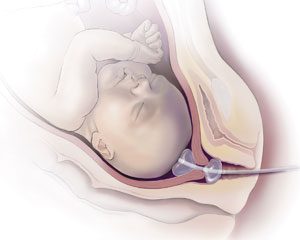Contents
Pregnancy balloon: what is it for, why use it?
Present in maternity wards and delivery rooms and childbirth preparation rooms, the pregnancy ball is a big inflatable gymnastics ball, made of rubber flexible, with a diameter ranging from 55 to 75 cm. After being assured that there are no contraindications related to their pregnancy and having selected the model that best suits their size, future and new mothers can use it for its multiple benefits: relieving pain, alleviating heavy legs, adopt a better posture, improve blood circulation or even rock and soothe baby.
What is a pregnancy balloon?
Also called gym ball, fitball or Swiss ball, the pregnancy ball is a large inflatable gymnastic ball, made of rubber flexible, with a diameter ranging from 55 to 75 cm. This one was created, in the 1960s, by physiotherapist Suzanne Klein, to help her patients relieve their back pain.
It was in the 90s that its use spread. Although it is not reserved for pregnant women, the pregnancy balloon has since become an essential accessory for future and new mothers, subject to favorable medical advice.
What is a pregnancy balloon used for?
During pregnancy
Through more or less dynamic exercises and relaxation, the use of the pregnancy ball allows future mothers to:
- relieve back pain due to the baby’s weight;
- lighten heavy legs;
- soften the constantly evolving body;
- adopt a better posture;
- keep a flexible and mobile pelvis;
- improve blood circulation;
- tone the perineum;
- relax ;
- rock the baby and soothe him.
During the birth,
The pregnancy ball can also be used to do pelvic mobility exercises between each contraction, thus making it possible to:
- accelerate childbirth;
- facilitate cervical dilation;
- relieve pain;
- find resting and comfortable positions to relax between each contraction;
- facilitate the descent of the baby.
After childbirth,
After childbirth, the pregnancy balloon can be very useful for:
- help in the rehabilitation of the perineum;
- gradually regain her pre-pregnancy figure;
- work on body tone;
- gently strengthen the abdominals, back and glutes.
How is a pregnancy ball used?
Subject to the agreement of the doctor, gynecologist or midwife, the pregnancy ball allows you to gently perform relaxation, gymnastics and stretching exercises. Here are some examples.
Relieve the lumbar
- sit on the ball with your feet propped up to shoulder space;
- put your hands on your hips or stretch your arms out in front of you;
- tilt the pelvis back and forth while maintaining the extreme position for a few seconds;
- repeat this movement about fifteen times.
Strengthen the back muscles
- carry the ball in front of you at arm’s length;
- turn from right to left, slowly, about ten times;
- then raise it and lower it still arms outstretched ten times.
Soften the back
- stand on a floor that does not slip;
- position the ball in the upper back, feet on the ground;
- balance with bent legs;
- move up and down the pelvis 5 to 6 times, breathing well.
Soften the cervix
- sit on the ball, legs bent and apart;
- perform circular movements with the pelvis;
- then stand on all fours on the ground;
- rest the forearms on the ball and let the stomach rest in the air;
- then stand with your back to a wall;
- position the ball between the wall and yourself;
- lean against the ball before gently rolling it.
Massaging heavy legs
- lie down on a floor mat;
- position the ball under the calves;
- roll it to massage the legs.
Precautions for use
- store the pregnancy balloon in a dry place, away from sunlight and humidity;
- avoid using it near a radiator or on heated floors;
- in the case of heated parquet, lay it on a carpet.
How to choose the right pregnancy balloon?
It exists various models of pregnancy balloons at various prices. Among the selection criteria, the size of the balloon remains the most important. It is available in three models classified according to the size of the user:
- Size S (55 cm in diameter): for expectant mothers measuring up to 1,65 m;
- Size M (65 cm in diameter): for expectant mothers measuring between 1,65 m and 1,85 m;
- Size L (75 cm in diameter): for expectant mothers over 1,85 m.
To make sure the model fits well, just:
- sit on the ball with your back straight and your feet on the ground;
- check that the knees are at the same height as the hips, in an optimal inflation condition.
A pregnancy ball that is too high risks accentuating the arch of the back. However, for pregnant women in whom the weight will change during pregnancy, it is recommended, for more comfort, to:
- take a balloon size above the usual size;
- inflate and / or deflate it depending on the progress of the pregnancy and the desired sensations.










